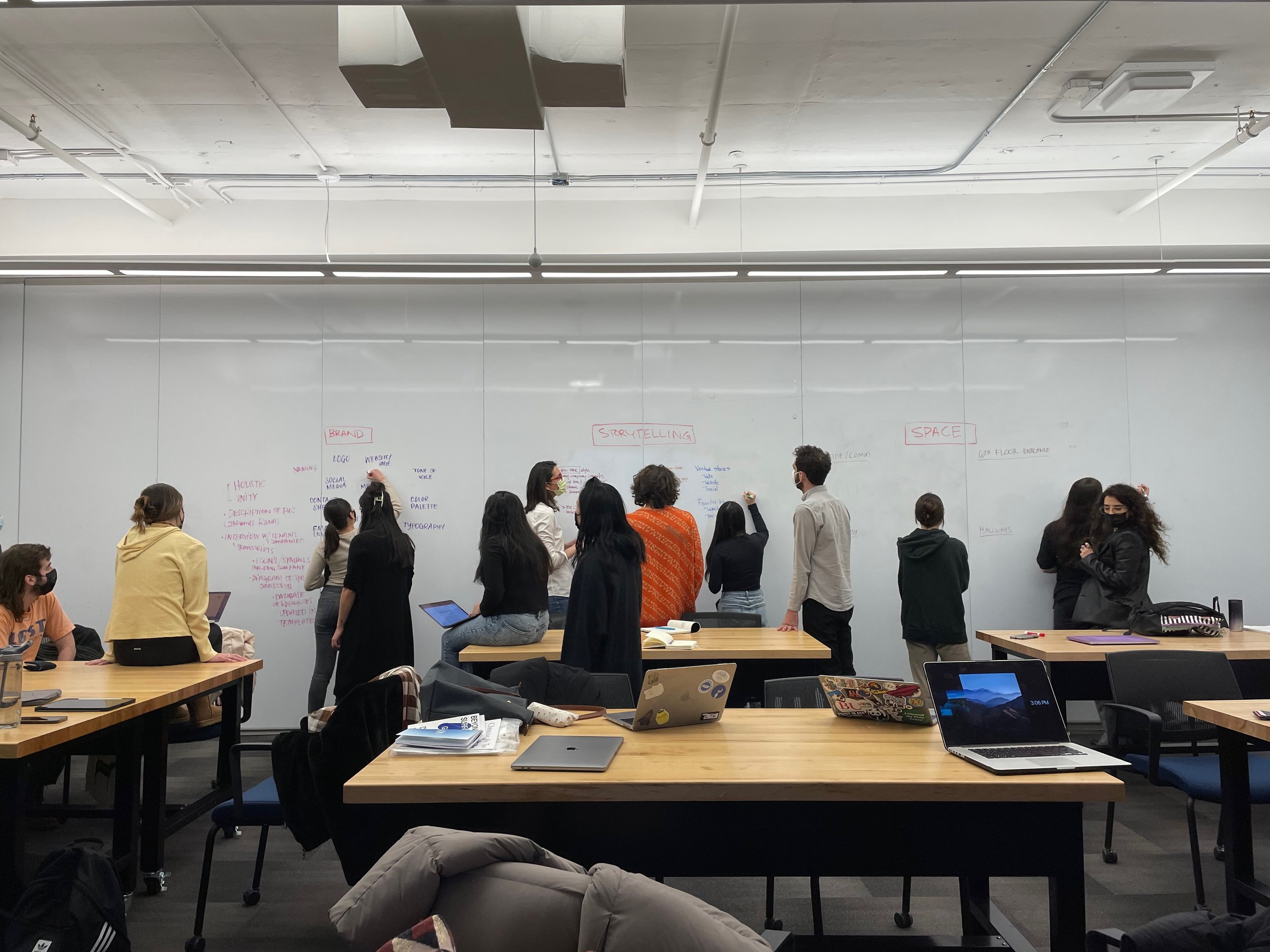Innovation in Design Pedagogy.
Innovation in design pedagogy has become increasingly important in recent years as the field of design, and technology continues to expand as we come out of a global pandemic and in a time where we are witnessing the failures of social systems. This societal growth and shift, alongside a critical reexamination of our industry, has prompted me to re-examine my teaching methods and practice and explore new theories and approaches to better prepare students for the current and future reality. In recent years while teaching graphic design at Boston University, my focus has been on three key areas:
The iterative development of a process and framework for inquiry
The creation of a framework and database for exploring works of experience design
The integration of a design activism mindset into the core graphic design curriculum
Advancing Graphic Design Graduate study by focusing on the iterative development of a process and framework for inquiry.
I redeveloped a core studio course in the MFA Graphic Design program at Boston University in 2019, redefining how graphic design graduate students developed their thesis work in the program for the first time in over a decade.
As a precursor to developing thesis work, I have instituted a new process of positioning students’ interests and ideas as a crucial foundational element for an MFA thesis through a public presentation of their design inquiry. My approach is to focus on the iterative development of a process and framework for inquiry—emphasizing the importance of experimentation and exploration in the design process and encouraging students to reflect continuously and refine their work. The framework encourages students to shape their interests, methods, and practice through questioning, researching, and analyzing broad contexts and reference points, generating and testing new ideas, and ultimately developing solutions that are both innovative and effective.
Students learn to think creatively, communicate effectively, and collaborate with others by focusing on the inquiry process. I have treated this thesis development framework like a software development project—iterating, improving, and adding new features year over year based upon learnings from the previous year. This iterative development of a process and framework for inquiry over the past four academic years, even amid the challenges posed by the pandemic, has solidified this approach as a crucial aspect of advancing graphic design graduate studies at Boston University.
Graduate programs in graphic design play a critical role in shaping the future of the field. With this approach, they can ensure that design remains a powerful tool for transforming how a new generation of young designers confronts the design industry with a critical mindset.
Framework and database as a handbook for exploring works of experience design.
I am developing a framework and database for exploring works of experience design as a reference tool and design education resource. This resource will provide a centralized, searchable collection of experience design case studies, organized and cataloged to allow quick and easy access to relevant information.
The development of this framework and database results from teaching experience design at Boston University and professional practice in design strategy working with consumer-facing businesses. The framework was initially designed to give students a more specific understanding and approach to creating opportunities for experiences and was later adapted to develop business leaders’ customer experience strategies. This development process allowed for additions and edits to the framework, ultimately creating a more practical and universal open resource.
Leveraging the framework as a teaching tool, I engaged students to populate a database with an initial set of experience design case studies over three semesters, yielding more than 250 rough case studies as a learning resource for subsequent classes while teaching students the relevance and effectiveness of creating case studies across a broad spectrum of industries. I am now using this initial data set to refine the framework, add to the database, and publish a beta version of the database later this year as a public-facing resource for the design, education, and business communities.
This framework and database will provide a valuable resource for those interested in experience design, offering a centralized collection of case studies organized and cataloged in a way that allows for quick and easy access to relevant information.
Integrating a design activism mindset into core graphic design curriculum.
Graphic design can influence and shape our world in meaningful ways. However, the traditional graphic design curriculum has often lacked focus on ethical and social responsibilities, inclusivity, and equity. I seek to rigorously integrate a design activism mindset into a core graphic design curriculum—elevating dialogue around using design to raise awareness, engage in activism, and drive social change. By incorporating a design activism mindset into the curriculum, students can learn how to use design as a tool for advocacy and activism and develop a deeper understanding of design’s role in shaping our world.
I have been developing a methodology for a design pedagogy through my experience design course that applies to the broader scope of a design curriculum:
Define opportunities for experience
See design as a process of discovery
Search out potential of opportunity rather than problems.
Leverage multi perspective storytelling
Practice radical empathy
Find commonalities through context
Witness impact
Work with not for
Slow down time and be present.
Embrace the constraint, and incorporate conflicts.
In addition, incorporating real-world projects that address social and political issues encourages students to engage with the broader community through their design work.
A more activist-oriented graphic design curriculum for a new generation of designers can help raise awareness of important social and political issues and drive positive change. It gives students a deeper understanding of design’s role in shaping our world and their responsibilities as designers. It also helps them develop the skills and knowledge they need to use design as a tool for advocacy and activism and empowers them to use their design skills to drive positive change.
